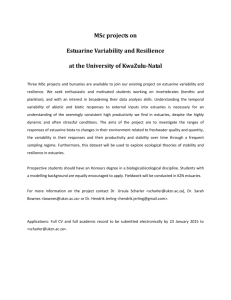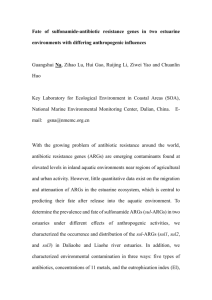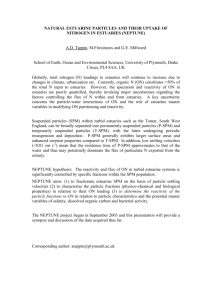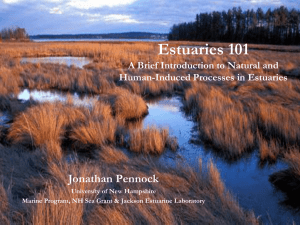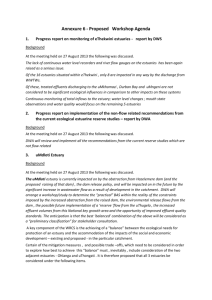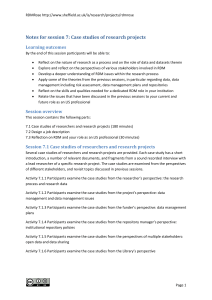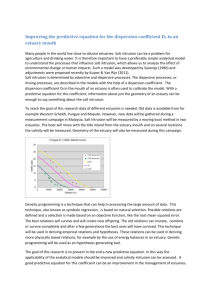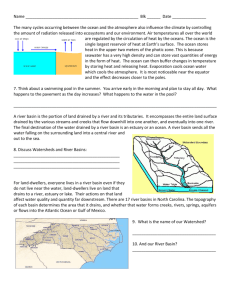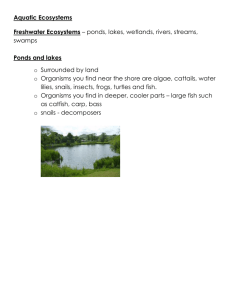Section B - Department of Water Affairs
advertisement
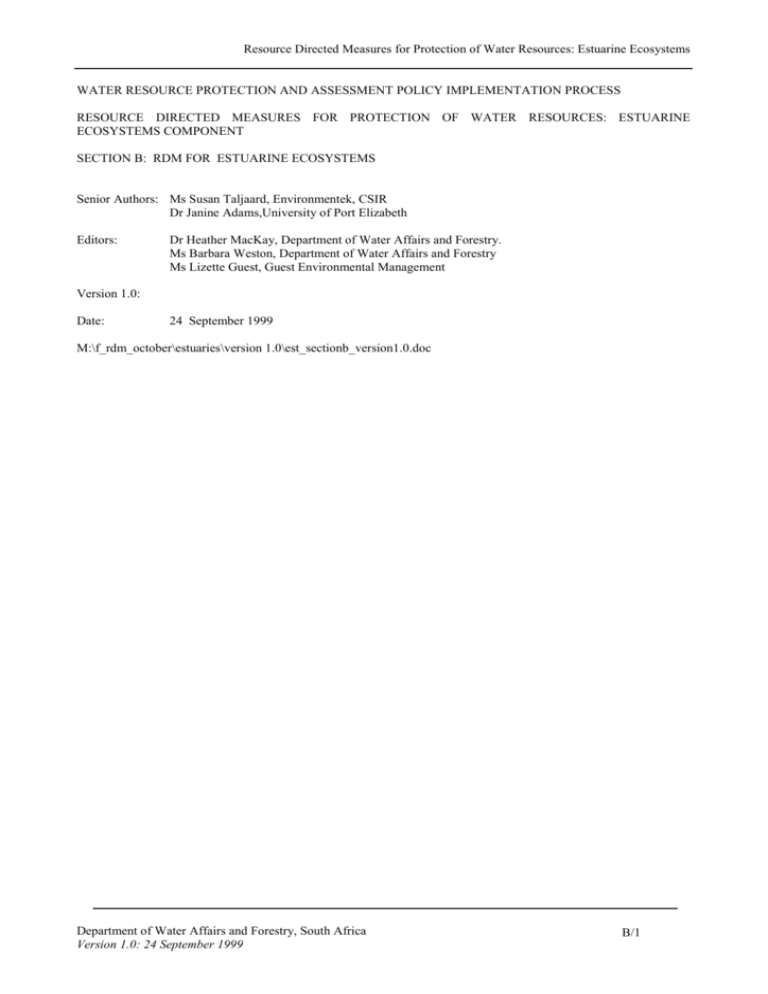
Resource Directed Measures for Protection of Water Resources: Estuarine Ecosystems WATER RESOURCE PROTECTION AND ASSESSMENT POLICY IMPLEMENTATION PROCESS RESOURCE DIRECTED MEASURES FOR PROTECTION OF WATER RESOURCES: ESTUARINE ECOSYSTEMS COMPONENT SECTION B: RDM FOR ESTUARINE ECOSYSTEMS Senior Authors: Ms Susan Taljaard, Environmentek, CSIR Dr Janine Adams,University of Port Elizabeth Editors: Dr Heather MacKay, Department of Water Affairs and Forestry. Ms Barbara Weston, Department of Water Affairs and Forestry Ms Lizette Guest, Guest Environmental Management Version 1.0: Date: 24 September 1999 M:\f_rdm_october\estuaries\version 1.0\est_sectionb_version1.0.doc Department of Water Affairs and Forestry, South Africa Version 1.0: 24 September 1999 B/1 Resource Directed Measures for Protection of Water Resources: Estuarine Ecosystems Section B: B.1 Resource Directed Measures for Estuarine Ecosystems Introduction According to the National Water (Act 36 of 1998) an estuary is defined as: a partially or fully enclosed water body that is open to the sea permanently or periodically, and within which the seawater can be diluted, to an extent that is measurable, with freshwater drained from land. There are 260 estuaries in South Africa which fall within this definition. A classification system has been developed for South African estuaries, based primarily on broad physical features of estuaries (Whitfield, 1992). The different classes of estuaries and their distribution in the three biogeographical regions (Figure B1) are given in Table B1. Table B.1: Classification of estuaries based on broad physical features of estuaries (Whitfield, 1992) ESTUARY TYPE BIOGEOGRAPHICAL REGION COOL TEMPERATE WARM TEMPERATE SUBTROPICAL Estuarine bay 0 1 2 Permanently open estuary 2 29 16 Estuarine lake 0 4 4 Temporarily open/closed estuary 10 86 90 Modified or canalised estuary 1 2 1 River mouth 1 7 4 A L OL CO Richards Bay TE A ER SU B MP TR TE O PI C Durban East London Saldanha Bay Port Elizabeth Cape Town WARM TEMPERATE Figure B.1: Biogeographical regions along the South African Coast Department of Water Affairs and Forestry, South Africa Version 1.0: 24 September 1999 B/2 Resource Directed Measures for Protection of Water Resources: Estuarine Ecosystems B.2 Generic RDM Methodology for Estuaries To assist in the development of the methodologies for determination of Resource Directed Measures for water resources, a generic RDM methodology was proposed that could be used as a reference framework from which the methodologies and procedures for different water resources might be developed. The steps to be addressed under each RDM level, as well as the level of detail required will, however, differ from one level to the other. The generic steps (refer to Section A of this manual) are: Step 1. Step 2. Step 3. Step 4. Step 5. Step 6. Step 7. B.2.1 Delineate the geographical boundaries of the resource unit Determine the eco-regional type of the resource unit Determine the reference conditions Determine the current status of the resource Select a Management Class Set the Resource Quality Objectives (RQO) Define future data/monitoring requirements Ecoregional typing for estuaries Although, Step 1 (delineation of the geographical boundaries) is applicable to estuaries, Step 2 may not be applicable. The classification system for South African estuaries (Whitfield, 1992) is primarily based on broad physical features of estuaries, subdivided into the three biogeographical regions. However, within these groups there are still large differences in terms of abiotic and biotic characteristics and processes (e.g. % natural MAR, size of the estuary, wave action in the mouth, geochemical characteristics of the adjacent marine environment as well as in the catchment and biotic composition). One of the purposes of Step 2 is to extrapolate information from one resource unit within a catchment to another, based on similarities in abiotic and biotic characteristics. Therefore the current estuarine classification system would need to be expanded further, i.e. include other abiotic and biotic features, before it could be applied effectively in this manner. It is important to recognize that each estuary is unique and different from any other estuary. For example two estuaries could occur adjacent to one another but completely different processes could be responsible for maintaining an open mouth due to differences in local coastal conditions e.g. rocky headlands, steep beaches. Careful consideration should therefore be applied in deriving general conclusions from the specific conditions in a particular estuary. At this stage it is therefore considered appropriate to delineate each estuary as a separate resource unit within the larger catchment, characterized by site dependent abiotic and biotic characteristics. B.2.2 Reference conditions for estuaries Ideally the reference condition of an estuary needs to be based on measured scientific data. However, where measured or published data on reference conditions are limited or not available, these conditions need to be estimated by using data and knowledge on the present condition. This is the case for most South African estuaries. A more realistic approach for estuaries would therefore be to carry out Step 3 in the generic methodology before Step 4. Generic RDM methodology for estuaries The generic methodology for the determination of RDM for estuaries is based on Figure 1 in Section A. The generic steps for the determination of RDM for estuaries are shown in Figure B.2 Department of Water Affairs and Forestry, South Africa Version 1.0: 24 September 1999 B/3 Resource Directed Measures for Protection of Water Resources: Estuarine Ecosystems Step 1: Delineate Geographical Boundaries Step 2: Determine Ecoregional Type (Not applicable to estuaries) Step 3a: Assess Present State Step 4a: Determine Present Ecological Status Step 5a: Determine Ecological Management Class Step 6a: Quantify Reserve Step 3b: Determine Reference Condition Step 4b: Determine Ecological Importance Step 5b: Set Ecological Management Class Step 6b: Set RQO Step 7: Design appropriate resource monitoring programme Figure B.2: The generic procedure for the determination of RDM for estuaries. Department of Water Affairs and Forestry, South Africa Version 1.0: 24 September 1999 B/4 Resource Directed Measures for Protection of Water Resources: Estuarine Ecosystems B.3 Levels of Assessment for Estuaries Four different levels of assessment of the ecological Reserve have been identified (Section A of this manual): Desktop estimate Rapid determination of RDM Intermediate determination of RDM Comprehensive determination of RDM. The rules for selection of the appropriate level of RDM determination are provided in the Integration Manual. The level of RDM used will be determined by: the degree to which the catchment is already utilised the sensitivity and importance of a catchment, and the potential impact of proposed water use. The purpose of the desktop estimate is to obtain a low confidence value for the reserve of a water resource for use in the National Water Balance model. However, the level of determination that will be required to obtain estimates for the National Water Balance model will be that described for the rapid determination of RDM. This procedure is set out in Section D. The procedures for the intermediate determination of RDM for estuaries are given in Section E. Data requirements for the comprehensive Reserve determination (Section F) have been compiled, but the detail of the overall methodology still needs to be formalised. Several studies have been undertaken in recent years to determine estuarine freshwater requirements (see appendix E1). The procedures set out in this manual for rapid, intermediate and comprehensive determinations of RDM for estuaries will still be pilot tested and refined during Phase 4 of the RDM project. B.4 Integration of the Estuarine Ecosystem other Components of the Reserve Requirements with Integration of estuarine and river flow requirements has been carried out in previous EFR and IFR studies, to ensure matching at the interface between the river and the estuary. Where an estuary is linked to a wetland or the groundwater has a significant influence on the water inflow to the estuary, integration with the RDM determinations of these water resources will need to take place. However, the process of integration and matching still needs to be formalised and will be documented during a future pilot study. Department of Water Affairs and Forestry, South Africa Version 1.0: 24 September 1999 B/5

